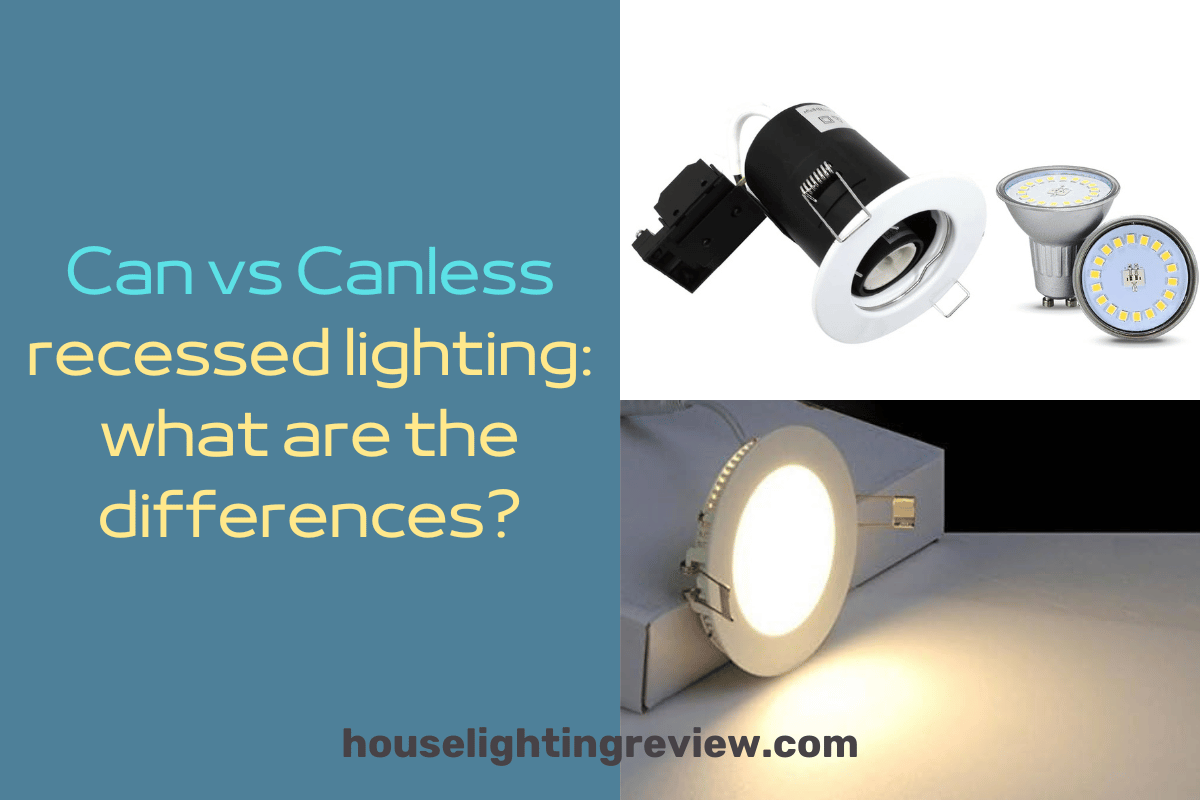Recessed lighting is a popular choice for its sleek, modern appearance and versatility when it comes to illuminating your home or office.

In this article, we will thoroughly compare can vs canless recessed lighting, considering various factors that can help you decide between the two types.
1. Performance and Light Output

When evaluating the performance and light output of can vs. canless recessed lights, consider your lighting needs and desired ambiance.
Canned Lights: Customizable and Adjustable

Can recessed lights, also known as pot lights, are highly customizable regarding light output. They can accommodate a range of bulb types, including incandescent lighting, LEDs, or halogen, allowing you to choose the one with suitable brightness and color temperature.
This light fixture provides excellent flexibility in creating different lighting moods, from bright to soft and ambient illumination.
Canless Lights: Modern and Efficient

Canless recessed light often comes with integrated LED lights modules, offering energy-efficient and long-lasting illumination. These light fixtures are known for their reliability and low maintenance requirements.
They provide consistent and uniform lighting, making them suitable for various applications, such as general room or accent lighting.
However, if lights stop working, the entire fixture would need to be replaced, which can be tough and time-consuming.
Can vs Canless Recessed Lighting: Performance and Light Output
Canned recessed lighting offers versatility and can tailor the lighting to your preference with various bulb options.
Canless recessed lighting is efficient and modern, providing uniform illumination with integrated LED bulbs, making them low-maintenance and cost-effective.
2. Installation and Space Considerations

When considering the installation of recessed lighting, it is also important to evaluate how it may affect the overall comfort of your space, including its interaction with the heat and air conditioning systems.
Can Lights: Traditional Installation

Installation of traditional can recessed lights requires a hole cut in the ceiling, running electrical wires, and installing a canister. This procedure may require a professional electrician due to its complexity.
This housing can take up additional space in the ceiling cavity, which may be an option in rooms with limited clearance or insulation.
While the installation process is straightforward, it can be more involved due to the need for the canister, especially in retrofit applications.
Canless Lights: Compact and Streamlined

Canless recessed lights are designed to be more compact and space-efficient. They often come as all-in-one lighting fixture, negating the requirement for separate housings.
It often involves cutting tiny hole in the ceiling and wiring the light fixture to the electrical box to install recessed lighting.
The streamlined design and simplified installation process make a canless recessed lighting system an appealing choice for homeowners seeking a more straightforward setup.
Can Lights vs Canless Lights: Installation and Space Considerations
Canned recessed lighting offers versatility but may require more space.
Canless lights prioritize efficiency and space-saving, making them an excellent choice for streamlined installations.
3. Energy Efficiency and Cost

When it comes to energy efficiency and cost considerations, your choice between can and canless recessed lighting should factor into your budget and environmental concerns.
Can Light: Bulb Flexibility and Operating Costs
Canned recessed lighting provides flexibility in choosing light bulb, allowing you to select energy-efficient options like LED bulb or fluorescent lights when desired. However, the overall energy efficiency and operating costs of can lights may vary depending on the bulb type chosen.
The incandescent bulb may consume more energy and have higher operating costs.
Unlike light bulbs, switching to LED light or fluorescent bulbs can significantly reduce energy consumption and long-term expenses.
Canless Light: Built-in LED Bulbs Efficiency
Canless recessed lights are often equipped with integrated led lights known for their energy efficiency and long lifespan. This built-in LED lights technology can result in lower energy consumption and reduced operating costs over time.
While the initial purchase cost may be slightly higher, the energy savings and extended lifespan of LED recessed light attached show canless lights as a budget-friendly option in the long run.
Canned Lights vs Canless Light: Energy Efficiency and Cost
Canned lights offer flexibility but may require careful light bulb selection to optimize energy efficiency.
Canless lights come with built-in LED light, which tend to be energy-efficient and cost-effective in the long term due to reduced energy consumption and extended lifespans.
4. Dimming and Smart Lighting Compatibility

Thinking about dimming and smart lighting compatibility is essential to ensure your lighting system can adapt to your desired level of control.
Can Lights: Dimming Options
Canned lights are often compatible with dimmer switches, providing you with the flexibility to adjust the light intensity. This dimming capability enhances the versatility of can light.
With the right dimmer switch and light bulbs, you can create customized lighting atmospheres that range from bright and functional to soft and relaxing.
Canless Lights: Smart Lighting Integration
Canless recessed lights may offer smart lighting integration options, allowing you to control remotely through smartphone apps or voice-activated assistants like Alexa or Google Assistant.
These smart lighting features provide advanced control and convenience, enabling you to customize color temperatures and brightness levels.
Can vs Canless Recessed Lighting: Dimming and Smart Lighting
Can light typically offers dimming capabilities when used with compatible light bulbs and dimmer switches, providing customizable lighting control.
Canless lights may offer smart lighting integration, allowing for remote control and advanced customization through smartphone apps or voice commands.
Conclusion
Can lights are known for their versatility and compatibility with various bulb types. They provide customization options and are ideal for those who appreciate timeless design.
Canless lights embrace modernity, offering a streamlined look and efficient installation. They often feature built-in LED lights for energy efficiency and can be a great fit for contemporary and minimalist interior designs.
Ultimately, your choice between can lights and canless recessed lights should closely align with your specific lighting goals, interior decor, and the desired functionality. Carefully weigh these factors to create the ideal recessed lighting ambiance within your living space.
Frequently Asked Questions
Which is better can or canless lights?
Canned recessed lights are generally longer lasting and easy to install, while canless lighting can often be energy efficient and can produce clean, modern looks.
Is canless recessed lighting safe?
Yes, canless recessed light is safe when installed and used according to manufacturer instructions and local electrical codes. Proper installation and compliance with safety standards ensure safe and reliable operation.
What is the difference between a can light and a recessed light?
They differ in installation method: canned lights cover a broader category of lighting fixtures that use a canister-like housing, while recessed lighting specifically refers to a subset of canned lights that are installed flush with the surface, creating a seamless appearance.
Do I need cans for LED recessed lighting?
No, you do not need traditional cans for LED recessed lighting. LED recessed lights are designed to be installed directly into the ceiling without using separate canisters.


